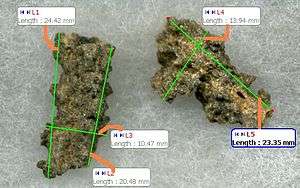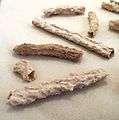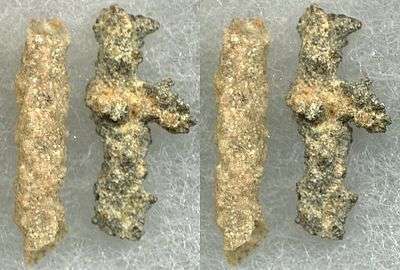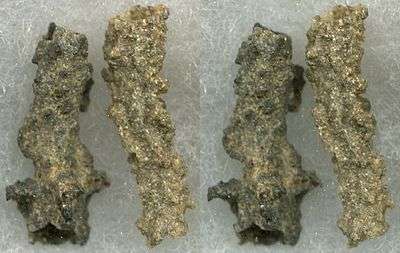Fulgurite
Fulgurite (from the Latin fulgur, meaning "lightning") are natural tubes, clumps, or masses of sintered, vitrified, and/or fused soil, sand, rock, organic debris and other sediments that sometimes form when lightning discharges into ground. Fulgurites are classified as a variety of the mineraloid lechatelierite. When ordinary negative polarity cloud-ground lightning discharges into a grounding substrate, greater than 100 million volts (100 MV) of potential difference may be bridged.[2] Such current may propagate into silica-rich quartzose sand, mixed soil, clay, or other sediments, rapidly vaporizing and melting resistant materials within such a common dissipation regime.[3] This results in the formation of generally hollow and/or vesicular, branching assemblages of glassy tubes, crusts, and clumped masses.[4] Fulgurites have no fixed composition because their chemical composition is determined by the physical and chemical properties of whatever material is being struck by lightning.

| ||
| ||
| ||
| ||
| ||
| Two Type I (arenaceous) fulgurites: a section of a common tube fulgurite and one exhibiting a branch. |
| ||
| ||
| ||
| ||
| ||
| Two small Type I Saharan Desert fulgurites.[1] In a planar view the specimen on the right has a blade-like morphology, but its tubular nature is dramatically shown in a stereo view. |

Fulgurites are structurally similar to Lichtenberg figures, which are the branching patterns produced on surfaces of insulators during dielectric breakdown by high-voltage discharges, such as lightning.[5][6]
Description
Fulgurites are formed when lightning strikes the ground, fusing and vitrifying mineral grains.[7] The primary SiO2 phase in common tube fulgurites is lechatelierite, an amorphous silica glass. Many fulgurites show some evidence of crystallization: in addition to glasses, many are partially protocrystalline or microcrystalline. Because fulgurites are generally amorphous in structure, fulgurites are classified as mineraloids.
Material properties (size, color, texture) of fulgurites vary widely, depending on the size of the lightning bolt and composition and moisture content of the surface struck by lightning. Most natural fulgurites fall on a spectrum from white, to black. Iron is a common impurity that can result in a deep brownish-green coloration. Lechatelierite similar to fulgurites can also be produced via controlled (or uncontrolled) arcing of artificial electricity into a medium. Downed high voltage power lines have produced brightly-colored lechatelierites, due to the incorporation of copper or other materials from the power lines themselves.[8] Brightly-colored lechatelierites resembling fulgurites are usually synthetic and reflect the incorporation of synthetic materials. However, lightning can strike man-made objects, resulting in colored fulgurites.
The interior of Type I (sand) fulgurites normally is smooth or lined with fine bubbles, while their exteriors are coated with rough sedimentary particles or small rocks. Other types or fulgurites are usually vesicular, and may lack an open central tube; their exteriors can be porous or smooth. Branching fulgurites display fractal-like self-similarity and structural scale invariance as a macroscopic or microscopic network of root-like branches, and can display this texture without central channels or obvious divergence from morphology of context or target (e.g. sheet-like melt, rock fulgurites). Fulgurites are usually fragile, making the field collection of large specimens difficult.
Fulgurites can exceed 20 centimeters in diameter and can penetrate deep into the subsoil, sometimes occurring as far as 15 m (49 ft) below the surface that was struck.[9] Or they may form directly on sedimentary surfaces.[10] One of the longest fulgurites to have been found in modern times was a little over 4.9 m (16 ft) in length, and was found in northern Florida.[11] The Yale University Peabody Museum of Natural History displays one of the longest known preserved fulgurites, approximately 4 m (13 ft) in length.[12] Charles Darwin in The Voyage of the Beagle recorded that tubes such as these found in Drigg, Cumberland, UK reached a length of 9.1 m (30 ft).[13][14] The Winans Lake fulgurite[s] (Winans Lake, Livingston County, Michigan), extended discontinuously throughout a 30 m range, and arguably includes the largest reported fulgurite mass ever recovered and described: its largest section extending approximately 16 ft (4.88 m) in length by 1 ft in diameter (30 cm).[4][15]
Peak temperatures within a lightning channel exceed 30,000 K, with sufficient pressure to produce planar deformation features in SiO2, a kind of polymorphism. This is also known colloquially as shocked quartz.[16]
Classification
Fulgurites have been classified by Pasek et al. (2012)[17] into five types related to the type of sediment in which the fulgurite formed, as follows:
- Type I - sand fulgurites with tubaceous structure; their central axial void may be collapsed
- Type II - soil fulgurites; these are glass-rich, and form in a wide range of sediment compositions, including clay-rich soils, silt-rich soils, gravel-rich soils, and loessoid; these may be tubaceous, branching, vesicular, irregular/slaggy, or may display a combination of these structures, and can produce exogenic fulgurites (droplet fulgurites)
- Type III - caliche or calcic sediment fulgurites, having thick, often surficially glazed granular walls with calcium-rich vitreous groundmass with little or no lechatelierite glass; their shapes are variable, with multiple narrow central channels common, and can span the entire range of morphological and structural variation for fulguritic objects
- Type IV - rock fulgurites, which are either crusts on minimally altered rocks, networks of tunneling within rocks, vesicular outgassed rocks (often glazed by a silicide-rich and/or metal oxide crust), or completely vitrified and dense rock material and masses of these forms with little sedimentary groundmass
- Type V - [droplet] fulgurites (exogenic fulgurites), which show evidence of ejection (e.g. spheroidal, filamentous, or aerodynamic),[3][17] related by composition to Type II and Type IV fulgurites
Significance
Paleoenvironmental indicator
The presence of fulgurites in an area can be used to estimate the frequency of lightning over a period of time, which can help to understand past regional climates. Paleolightning is the study of various indicators of past lightning strikes, primarily in the form of fulgurites and lightning-induced remanent magnetization (LIRM) signatures.[1]
Place in planetary processes and the geologic record
Many high-pressure, high-temperature materials have been observed in fulgurites. Many of these minerals and compounds are also known to be formed in extreme environments such as nuclear weapon tests, hypervelocity impacts, and interstellar space. Shocked quartz was first described in fulgurites in 1980.[18] Other materials, including highly reduced silicon-metal alloys (silicides), the fullerene allotropes C60 (buckminsterfullerenes) and C70, as well as high-pressure polymorphs of SiO2, have since been identified in fulgurites.[4][16][15][19][20][21][22][23][24][25][26][27][28]
Reduced phosphides have been identified in fulgurites, in the form of schreibersite (Fe3P, (Fe,Ni)3P), and titanium(III) phosphide (TiP).[4][29][30] These reduced compounds are otherwise rare on Earth due to the presence of oxygen in Earth's atmosphere, which creates oxidizing surface conditions.
Gallery
- Type I (sand) fulgurite, Okeechobee, Florida.
 Sand fulgurites, highly weathered (paleofulgurites) Algeria
Sand fulgurites, highly weathered (paleofulgurites) Algeria.jpg) Fulgurite, Mauritanian desert
Fulgurite, Mauritanian desert.jpg) Fulgurites, Mauritanian desert
Fulgurites, Mauritanian desert Fulgurites, Senne, Westphalia, Germany
Fulgurites, Senne, Westphalia, Germany- Tubaceous fulgurite, Iwamizawa, Japan
- Type II (soil, clastic) tubaceous fulgurite, Lancaster, California
See also
References
- Sponholz, B.; Baumhauer, R.; Felix-Henningsen, P. (1 June 1993). "Fulgurites in the southern Central Sahara, Republic of Niger and their palaeoenvironmental significance". The Holocene. 3 (2): 97–104. Bibcode:1993Holoc...3...97S. CiteSeerX 10.1.1.549.8976. doi:10.1177/095968369300300201.
- Ann Cooper, Mary (1980-03-01). "Lightning injuries: Prognostic signs for death". Annals of Emergency Medicine. 9 (3). doi:10.1016/S0196-0644(80)80268-X. Retrieved 2019-06-16.
- Joseph, Michael L. (January 2012). "A Geochemical Analysis of Fulgurites: from the inner glass to the outer crust" (PDF). Scholarcommons.usf.edu. Retrieved 2015-08-16.
- "Fulgurite Classification, Petrology, and Implications for Planetary Processes - The University of Arizona Campus Repository" (PDF). Arizona.openrepository.com. Archived (PDF) from the original on December 21, 2019. Retrieved 2015-08-16.
- "SGSMP : Lichtenberg figures". Sgsmp.ch. 2005-07-28. Archived from the original on 2015-08-02. Retrieved 2015-08-16.
- Ouellette, Jennifer (23 July 2013). "Fermilab Physicist Makes "Frozen Lightning" Art with Accelerators". Scientific American blog. Retrieved 11 August 2015.
- Essene, E. J.; Fisher, D. C. (1986-10-10). "Lightning Strike Fusion: Extreme Reduction and Metal-Silicate Liquid Immiscibility". Science. 234 (4773): 189–193. Bibcode:1986Sci...234..189E. doi:10.1126/science.234.4773.189. PMID 17746479.
- "The Agatelady: Adventures and Events: More about Fulgurites". 2014-09-18.
- W. Wright Jr., Fred (1988-07-01). "Florida's Fantastic Fulgurite Find" (PDF). Weatherwise. 51 (4). Retrieved 2019-06-16.
- Ripley, George; Dana, Charles Anderson (1859). The New American Cyclopaedia. Appleton. p. 2.
- Grapes, R. H. (2006). Pyrometamorphism. Springer. p. 28. ISBN 978-3-540-29453-5.
- "New Peabody hall offering high-tech lessons about Earth and space". Yale Bulletin & Calendar. 34 (30). June 9, 2006. Archived from the original on November 6, 2014. Retrieved 2013-12-26.
- "Presenting... Fulgurites". Oum.ox.ac.uk. Retrieved 2015-08-16.
- The popular educator - Books on Google Play. 1860. Retrieved 2015-08-16.
- Essene, E. J.; Fisher, D. C. (1986-10-10). "Lightning strike fusion: extreme reduction and metal-silicate liquid immiscibility". Science. Science-AAAS. 234 (4773): 189–193. Bibcode:1986Sci...234..189E. doi:10.1126/science.234.4773.189. PMID 17746479.
- Gieré, Reto; Wimmenauer, Wolfhard; Müller-Sigmund, Hiltrud; Wirth, Richard; Lumpkin, Gregory R.; Smith, Katherine L. (2015-07-01). "Lightning-induced shock lamellae in quartz". American Mineralogist. 100 (7): 1645–1648. Bibcode:2015AmMin.100.1645G. doi:10.2138/am-2015-5218. Retrieved 2015-08-16.
- Pasek, Matthew A.; Block, Kristin; Pasek, Virginia (2012-04-24). "Fulgurite morphology: a classification scheme and clues to formation - Springer". Contributions to Mineralogy and Petrology. 164 (3): 477–492. Bibcode:2012CoMP..164..477P. doi:10.1007/s00410-012-0753-5.
- Gailliot, Mary Patricia (1980-01-01). "Petrified Lightning". Rocks & Minerals. 55 (1): 13–17. doi:10.1080/00357529.1980.11764615.
- Daly, TK; Buseck, PR; Williams, P; Lewis, CF (2015-04-20). "Fullerenes from a fulgurite". Science. 259 (5101): 1599–601. Bibcode:1993Sci...259.1599D. doi:10.1126/science.259.5101.1599. PMID 17733026.
- Heymann, D. (1996). "Chemistry of Fullerenes on the Earth and in the Solar System : A 1995 Review" (PDF). LPS. XXVII: 539. Bibcode:1996LPI....27..539H. Retrieved 2015-08-16.
- Macdonald, F.A.; Mitchell, K.; Cina, S.E. (2004). "Evidence for a Lightning-Strike Origin of the Edeowie Glass" (PDF). Lunar and Planetary Science. XXXV: 1406. Bibcode:2004LPI....35.1406M. Retrieved 2015-08-16.
- Pasek, M.A.; Collins, G.S.; Melosh, H.J.; Atlas, Z. (2010). "Shocked Quartz in a Fulgurite" (PDF). Meteoritics and Planetary Science. 73: 5211. Bibcode:2010M&PSA..73.5211P. Retrieved 2019-06-16.
- Carter, EA; Pasek, MA; Smith, T; Kee, TP; Hines, P; Edwards, HG (2015-04-20). "Rapid Raman mapping of a fulgurite". Anal Bioanal Chem. 397 (7): 2647–58. doi:10.1007/s00216-010-3593-z. PMID 20229006.
- Carter, Elizabeth A.; Hargreaves, Michael D.; Kee, Terence P.; Pasek, Matthew A.; Edwards, Howell G. M. (2010-06-07). "A Raman spectroscopic study of a fulgurite | Philosophical Transactions of the Royal Society of London A: Mathematical, Physical and Engineering Sciences". Philosophical Transactions of the Royal Society A: Mathematical, Physical and Engineering Sciences. 368 (1922): 3087–3097. doi:10.1098/rsta.2010.0022. PMID 20529946.
- Archived September 30, 2009, at the Wayback Machine
- Sheffer, A.A.; Dyar, M.D.; Sklute, E.C. (2006). "Lightning Strike Glasses as an Analog for Impact Glasses" (PDF). Lunar and Planetary Science. XXXVII. Retrieved 2015-08-16.
- Kochemasov, G.G. "Fulgurite" (PDF). Lunar and Planetary Science. Retrieved 2015-08-16.
- Parnell, J.; Thackrey, S.; Muirhead, D.; Wright, A. (2008). "Transient High-Temperature Processing of Silicates in Fulgurites as Analogues for Meteorite and Impact Melts" (PDF). Lunar and Planetary Science. XXXIX (1391): 1286. Bibcode:2008LPI....39.1286P. Retrieved 2015-08-16.
- Block, Kristin; Pasek, Matthew (August 2009). "Lightning-induced reduction of phosphorus oxidation state". Nature Geoscience. 2 (8): 553–556. Bibcode:2009NatGe...2..553P. doi:10.1038/ngeo580.
- Pasek, M.A.; Kee, T.P.; Carter, E.A.; Hargreaves, M.D.; H.G.M. Edwards; Z.Atlas (2010). "Fried Phosphate and Organic Survival : Lightning in Biogeochemical Cycles" (PDF). Astrobiology Sciences Conference. 1538: 5261. Bibcode:2010LPICo1538.5261P. Retrieved 2015-08-16.
External links
| Wikimedia Commons has media related to Fulgurites. |
- . Encyclopædia Britannica. 11 (11th ed.). 1911.
- H. J. Melosh, Impact geologists, beware! Geophysical Research Letters, Volume44, Issue17, Pages 8873–8874, 2017
- Petrified Lightning by Peter E. Viemeister (pdf)
- Interview (The Event: Petrified Lightning from Central Florida) with artist Allan McCollum along with an historical archive of sixty-six
- Mindat with location data
- W. M. Myers and Albert B. Peck, A Fulgurite from South Amboy, New Jersey, American Mineralogist, Volume 10, pages 152–155, 1925
- Vladimir A. Rakov, Lightning Makes Glass, 29th Annual Conference of the Glass Art Society, Tampa, Florida, 1999

